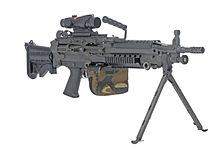
A bipod, also known as a tripod, is an attachment, usually to a weapon, that helps support and steady it. The bipod provides significant stability along two axes of motion (side-to-side, and up-and-down).
Bipod comes from the Latin and Greek roots bi and pod, meaning "two" and "foot, or feet" respectively.[1]
Firearms
On firearms, bipods are commonly used on rifles and machine guns to provide a forward rest and reduce motion. They are also seen on other long-barrelled weapons. Bipods permit operators to easily rest a weapon on objects, like the ground or a wall, reducing their fatigue and increasing accuracy and stability. Bipods can be of fixed or adjustable length. Some can be tilted and also have their tilting point close to the barrel's central axis, allowing the weapon to tilt left and right. Some designs also allow the weapon to be rotated side-to-side. There are three ways for bipods to be folded: away from the shooter, towards the shooter, or into a vertical foregrip.
History
The first known use of bipods on firearms can be traced back to hand cannons of the 12th century which were cast iron barrels laid on top of short poles.[2]
Bipods on rifles are first known to have been used in an improvised fashion during the mid-19th century, particularly by frontiersmen hunting American bison and other wild animals. For example, the painting "The Long Shot" by Howard Terpning[3] shows native American hunters shooting a rifle with an improvised bipod consisting of two crossed arrows.
During the 20th century, use of dedicated bipods increased, and was seen on different types of rifles during wars. For example the Lewis gun (1914) was fitted with an adjustable bipod.[4] The technology became more advanced, with hinged legs and even extendable or retractable legs.
One of the first companies to manufacture commercially successful bipods was Harris Engineering, Inc founded in 1979 in Barlow, Kentucky by Gerald Harris, Margaret Harris, and Susan Wilkerson. Before starting the company, Gerald had applied for a patent on the bipod.[5] In 2019, their successful Harris Bipods have been produced for nearly forty years, and have remained relatively unchanged.
Recent advances in manufacture of bipods include use of lightweight materials such as aluminium, carbon fiber and titanium, use of different quick attachment and detachment mechanisms (Picatinny, M-LOK, etc. or even magnets[6]) and various types of feet materials such as rubber, metal, or a "basket" designed to stop the bipod from sinking into soft surfaces such as fine sand or deep snow (inspired by ski poles and snowshoes).[7]
Mounting standards
There are several mounting standards for attaching a bipod to a rifle, of which some well known are swivel stud, Picatinny and Versa Pod spigot mount. Starting in the late 2010s, the Arca-Swiss style also gained popularity in shooting competitions such as the Precision Rifle Series since the rail allows for stepless adjustment.[8]
See also
References
- ^ "Bipod-Definition and More". Retrieved 10 February 2012.
- ^ BLK LBL Bipod | Two legs are better than one–the evolution and history of bipods
- ^ The painting "The Long Shot" by Howard Terpning
- ^ Weapons History - Lewis Gun
- ^ US3327422A - Bipod for attachment to a firearm - Google Patents
- ^ Steinert NeoPod Bipod | Bipod Reviews | Gun Mart
- ^ Soft Surface Bipod Platform (SSBP) by Mission Critical Designs
- ^ SHOT Show 2018: Really Right Stuff's New Products - PrecisionRifleBlog.com